 Photo ©
Kevin McGowan
Photo ©
Kevin McGowan
Providing Nesting Materials Safely
Birds’ nests are works of art, woven fibers and sculpted mud. Sometimes those gorgeous nests contain human-made materials such as cotton threads or plastic tinsel. Even your dog’s fur or a horse’s mane can be incorporated into a bird’s nest.
It is tempting to provide these easy-to-gather materials for birds; however, new evidence from wildlife rehabilitators suggests that caution is warranted when putting out nesting materials. Even fur and other seemingly innocuous materials can tangle and entrap adults and nestlings. In light of this new data, the Lab has recently revised its list of Dos and Don’ts for providing nesting materials to birds. See also: our blog post about what nest materials are best to provide for birds.
Do your part and keep birds safe this nesting season!
Do provide any combination of the following: dead twigs and leaves, dry grass (make sure the grass is chemical-free), feathers, plant fluff or down (e.g., cattail fluff, cottonwood down), moss, bark strips, and pine needles.
Don’t provide: plastic strips, tinsel, cellophane, aluminum foil, dryer lint, animal fur or hair (including human hair), yarn, felt, or bits of cloth.
 Photo ©
Photo ©